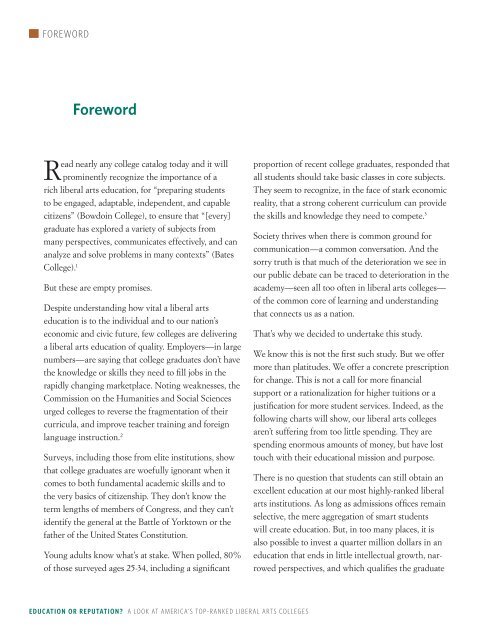k4yqkhk
k4yqkhk
k4yqkhk
Create successful ePaper yourself
Turn your PDF publications into a flip-book with our unique Google optimized e-Paper software.
FOREWORDForewordRead nearly any college catalog today and it willprominently recognize the importance of arich liberal arts education, for “preparing studentsto be engaged, adaptable, independent, and capablecitizens” (Bowdoin College), to ensure that “[every]graduate has explored a variety of subjects frommany perspectives, communicates effectively, and cananalyze and solve problems in many contexts” (BatesCollege). 1But these are empty promises.Despite understanding how vital a liberal artseducation is to the individual and to our nation’seconomic and civic future, few colleges are deliveringa liberal arts education of quality. Employers—in largenumbers—are saying that college graduates don’t havethe knowledge or skills they need to fill jobs in therapidly changing marketplace. Noting weaknesses, theCommission on the Humanities and Social Sciencesurged colleges to reverse the fragmentation of theircurricula, and improve teacher training and foreignlanguage instruction. 2Surveys, including those from elite institutions, showthat college graduates are woefully ignorant when itcomes to both fundamental academic skills and tothe very basics of citizenship. They don’t know theterm lengths of members of Congress, and they can’tidentify the general at the Battle of Yorktown or thefather of the United States Constitution.Young adults know what’s at stake. When polled, 80%of those surveyed ages 25-34, including a significantproportion of recent college graduates, responded thatall students should take basic classes in core subjects.They seem to recognize, in the face of stark economicreality, that a strong coherent curriculum can providethe skills and knowledge they need to compete. 3Society thrives when there is common ground forcommunication—a common conversation. And thesorry truth is that much of the deterioration we see inour public debate can be traced to deterioration in theacademy—seen all too often in liberal arts colleges—of the common core of learning and understandingthat connects us as a nation.That’s why we decided to undertake this study.We know this is not the first such study. But we offermore than platitudes. We offer a concrete prescriptionfor change. This is not a call for more financialsupport or a rationalization for higher tuitions or ajustification for more student services. Indeed, as thefollowing charts will show, our liberal arts collegesaren’t suffering from too little spending. They arespending enormous amounts of money, but have losttouch with their educational mission and purpose.There is no question that students can still obtain anexcellent education at our most highly-ranked liberalarts institutions. As long as admissions offices remainselective, the mere aggregation of smart studentswill create education. But, in too many places, it isalso possible to invest a quarter million dollars in aneducation that ends in little intellectual growth, narrowedperspectives, and which qualifies the graduateEDUCATION OR REPUTATION? A look at America’s Top-raNKed Liberal Arts COLLEGES


